Assessment of State Transition Dynamics of Coastal Wetlands in Northern Venice Lagoon, Italy
Abstract
1. Introduction
2. Study Area: The Lido Basin in the Venice Lagoon
2.1. Climate Settings
2.2. Characterization of Dominant Processes
2.3. Characterization of Tidal Regime
3. Materials and Methods
3.1. Materials
3.2. Methodology
3.2.1. Image Field-Based Analysis
- The target cell: the goal to achieve. In this case, obtaining the minimum difference (Δρ(λ)) between the simulated spectral signature (ρ(λ)0) and the reference one (ρ(λ)linear).
- The changing cells: the cells of the spreadsheet that can be adjusted to optimize the target cell. In this case, the endmember fraction ().
- The constraints: the restrictions placed on the changing cells.
3.2.2. Spatiotemporal Analysis
Temporal Trends: The Empirical Orthogonal Function
Spatial Trends: The Power Law Distribution
4. Results
4.1. Image Field-Based Analysis
4.1.1. Endmembers’ Validation: The Field Spectral Library
4.1.2. Classification of Spatial Patterns
4.1.3. Rate of Variation in the Spatial Patterns’ Distribution
4.2. Spatiotemporal Analysis
4.2.1. Temporal Trends: The Empirical Orthogonal Function (EOF)
4.2.2. Spatial Trends: The Power Law Distribution (PLD)
5. Discussion
- Step A: Subtidal areas, which are colonized by seagrass, are better protected against erosion compared to unvegetated areas. The ability of vegetation to reduce the applied bed shear stress enhances deposition of suspended sediment.
- Step B: Vertical accretion can occur over time; bottom sediments are elevated from a subtidal to an intertidal environment, where time of exposure is higher.
- Step C: Micro-organisms (diatoms and cyanobacteria), which are more abundant in intertidal environments, start colonizing the substrata producing Extracellular Polymeric Substances (EPS), particularly during summer and intertidal exposure, and increasing the erosion threshold and sediment stability (i.e., resistance against sediment waves and tidal currents).
6. Conclusions
Author Contributions
Funding
Institutional Review Board Statement
Informed Consent Statement
Data Availability Statement
Acknowledgments
Conflicts of Interest
Appendix A. Satellite Data Used
| Acquisition | Sensor | Path | Row | Tide Level (cm) |
|---|---|---|---|---|
| 25/06/1990 | TM | 192 | 28 | 11.3 |
| 30/07/1991 | TM | 192 | 28 | 21.0 |
| 09/08/1992 | TM | 192 | 28 | 21.0 |
| 04/07/1993 | TM | 191 | 29 | 6.7 |
| 14/07/1994 | TM | 192 | 28 | 12.7 |
| 03/08/2001 | ETM+ | 191 | 29 | 25.5 |
| 18/05/2002 | ETM+ | 191 | 29 | 22.0 |
| 27/06/2002 | TM | 191 | 29 | 18.7 |
| 07/06/2004 | TM | 192 | 28 | 30.8 |
| 29/07/2005 | ETM+ | 191 | 28 | 31.3 |
| 10/09/2006 | TM | 191 | 29 | 13.8 |
| 12/10/2006 | TM | 191 | 29 | 28.2 |
| 24/05/2007 | TM | 191 | 29 | 30.3 |
| 27/07/2007 | TM | 191 | 29 | 32.3 |
| 14/06/2009 | TM | 191 | 29 | 34.4 |
| 16/07/2009 | TM | 191 | 29 | 24.0 |
| 03/07/2010 | TM | 191 | 29 | 28.4 |
| 22/07/2011 | TM | 191 | 29 | 39.0 |
References
- Church, M.; Dudill, A.; Venditti, J.G.; Frey, P. Are Results in Geomorphology Reproducible? J. Geophys. Res. Earth Surf. 2020, 125. [Google Scholar] [CrossRef]
- Dietrich, W.E.; Perron, J.T. The search for a topographic signature of life. Nature 2006, 439, 411–418. [Google Scholar] [CrossRef]
- Kirwan, M.L.; Murray, A.B. Tidal marshes as disequilibrium landscapes? Lags between morphology and Holocene sea level change. Geophys. Res. Lett. 2008, 35, L24401. [Google Scholar] [CrossRef]
- Kirwan, M.L.; Murray, A.B. Ecological and morphological response of brackish tidal marshland to the next century of sea level rise: Westham Island, British Columbia. Glob. Planet. Chang. 2008, 60, 471–486. [Google Scholar] [CrossRef]
- Corenblit, D.; Steiger, J. Vegetation as a major conductor of geomorphic changes on the Earth surface: Toward evolutionary geomorphology. Earth Surf. Process. Landf. 2009, 34, 891–896. [Google Scholar] [CrossRef]
- Reinhardt, L.; Jerolmack, D.; Cardinale, B.J.; Vanacker, V.; Wright, J. Dynamic interactions of life and its landscape: Feedbacks at the interface of geomorphology and ecology. Earth Surf. Process. Landf. 2010, 35, 78–101. [Google Scholar] [CrossRef]
- Zhang, X.; Fichot, C.G.; Baracco, C.; Guo, R.; Neugebauer, S.; Bengtsson, Z.; Ganju, N.; Fagherazzi, S. Determining the drivers of suspended sediment dynamics in tidal marsh-influenced estuaries using high-resolution ocean color remote sensing. Remote Sens. Environ. 2020, 240, 111682. [Google Scholar] [CrossRef]
- Marani, M.; Belluco, E.; Ferrari, S.; Silvestri, S.; D’Alpaos, A.; Lanzoni, S.; Feola, A.; Rinaldo, A. Analysis, synthesis and modelling of high-resolution observations of salt-marsh eco-geomorphological patterns in the Venice lagoon. Estuar. Coast. Shelf Sci. 2006, 69, 414–426. [Google Scholar] [CrossRef]
- Carr, J.A.; D’Odorico, P.; McGlathery, K.J.; Wiberg, P.L. Modeling the effects of climate change on eelgrass stability and resilience: Future scenarios and leading indicators of collapse. Mar. Ecol. Prog. Ser. 2012, 448, 289–301. [Google Scholar] [CrossRef]
- Carr, J.A.; D’Odorico, P.; McGlathery, K.J.; Wiberg, P.L. Stability and resilience of seagrass meadows to seasonal and interannual dynamics and environmental stress. J. Geophys. Res. Biogeosci. 2012, 117. [Google Scholar] [CrossRef]
- Fagherazzi, S.; Kirwan, M.L.; Mudd, S.M.; Guntenspergen, G.R.; Temmerman, S.; D’Alpaos, A.; Van De Koppel, J.; Rybczyk, J.M.; Reyes, E.; Craft, C.; et al. Numerical models of salt marsh evolution: Ecological, geomorphic, and climatic factors. Rev. Geophys. 2012, 50. [Google Scholar] [CrossRef]
- Mariotti, G.; Fagherazzi, S. A numerical model for the coupled long-term evolution of salt marshes and tidal flats. J. Geophys. Res. Earth Surf. 2010, 115. [Google Scholar] [CrossRef]
- Taramelli, A.; Valentini, E.; Cornacchia, L. Remote sensing solutions to monitor biotic and abiotic dynamics in coastal ecosystems. In Coastal Zones: Solutions for the 21st Century; Elsevier Inc.: Amsterdam, The Netherlands, 2015; pp. 125–138. ISBN 9780128027592. [Google Scholar]
- Murray, A.B.; Lazarus, E.; Ashton, A.; Baas, A.; Coco, G.; Coulthard, T.; Fonstad, M.; Haff, P.; McNamara, D.; Paola, C.; et al. Geomorphology, complexity, and the emerging science of the Earth’s surface. Geomorphology 2009, 103, 496–505. [Google Scholar] [CrossRef]
- Black, K.S.; Paterson, D.M. LISP-UK Littoral Investigation of Sediment Properties: An introduction. Geol. Soc. Spec. Publ. 1998, 139, 1–10. [Google Scholar] [CrossRef]
- Conley, D.J. Biogeochemical nutrient cycles and nutrient management strategies. Hydrobiologia 1999, 410, 87–96. [Google Scholar] [CrossRef]
- Wang, C.; Schepers, L.; Kirwan, M.L.; Belluco, E.; D’Alpaos, A.; Wang, Q.; Yin, S.; Temmerman, S. Different coastal marsh sites reflect similar topographic conditions for bare patches and vegetation recovery. Earth Surf. Dyn. Discuss. 2021, 9, 71–88. [Google Scholar] [CrossRef]
- Amos, C.L.; Bergamasco, A.; Umgiesser, G.; Cappucci, S.; Cloutier, D.; Denat, L.; Flindt, M.; Bonardi, M.; Cristante, S. The stability of tidal flats in Venice Lagoon—The results of in-situ measurements using two benthic, annular flumes. J. Mar. Syst. 2004, 51, 211–241. [Google Scholar] [CrossRef]
- Cappucci, S.; Amos, C.L.; Hosoe, T.; Umgiesser, G. SLIM: A numerical model to evaluate the factors controlling the evolution of intertidal mudflats in Venice Lagoon, Italy. J. Mar. Syst. 2004, 51, 257–280. [Google Scholar] [CrossRef]
- Dyer, K.R. The typology of intertidal mudflats. Geol. Soc. Spec. Publ. 1998, 139, 11–24. [Google Scholar] [CrossRef]
- Dyer, K.R.; Christie, M.C.; Feates, N.; Fennessy, M.J.; Pejrup, M.; Van Der Lee, W. An investigation into processes influencing the morphodynamics of an intertidal mudflat, the Dollard Estuary, the Netherlands: I. Hydrodynamics and suspended sediment. Estuar. Coast. Shelf Sci. 2000, 50, 607–625. [Google Scholar] [CrossRef]
- Wang, C.; Temmerman, S. Does biogeomorphic feedback lead to abrupt shifts between alternative landscape states?: An empirical study on intertidal flats and marshes. J. Geophys. Res. Earth Surf. 2013, 118, 229–240. [Google Scholar] [CrossRef]
- Adam, P. Saltmarsh Ecology; Cambridge University Press: Cambridge, MA, USA, 1990; ISBN 9780521245081. [Google Scholar]
- Vandenbruwaene, W.; Temmerman, S.; Bouma, T.J.; Klaassen, P.C.; De Vries, M.B.; Callaghan, D.P.; Van Steeg, P.; Dekker, F.; Van Duren, L.A.; Martini, E.; et al. Flow interaction with dynamic vegetation patches: Implications for biogeomorphic evolution of a tidal landscape. J. Geophys. Res. Earth Surf. 2011, 116. [Google Scholar] [CrossRef]
- Weerman, E.J.; Van Belzen, J.; Rietkerk, M.; Temmerman, S.; Kéfi, S.; Herman, P.M.J.; Van De Koppel, J. Changes in diatom patch-size distribution and degradation in a spatially self-organized intertidal mudflat ecosystem. Ecology 2012, 93, 608–618. [Google Scholar] [CrossRef]
- Taramelli, A.; Valentini, E.; Cornacchia, L.; Mandrone, S.; Monbaliu, J.; Hoggart, S.P.G.; Thompson, R.C.; Zanuttigh, B. Modeling uncertainty in estuarine system by means of combined approach of optical and radar remote sensing. Coast. Eng. 2014, 87, 77–96. [Google Scholar] [CrossRef]
- Taramelli, A.; Valentini, E.; Cornacchia, L.; Monbaliu, J.; Sabbe, K. Indications of Dynamic Effects on Scaling Relationships Between Channel Sinuosity and Vegetation Patch Size Across a Salt Marsh Platform. J. Geophys. Res. Earth Surf. 2018, 123, 2714–2731. [Google Scholar] [CrossRef]
- Taramelli, A.; Valentini, E.; Cornacchia, L.; Bozzeda, F. A Hybrid Power Law Approach for Spatial and Temporal Pattern Analysis of Salt Marsh Evolution. J. Coast. Res. 2017, 77, 62–72. [Google Scholar] [CrossRef]
- Rietkerk, M.; van de Koppel, J. Regular pattern formation in real ecosystems. Trends Ecol. Evol. 2008, 23, 169–175. [Google Scholar] [CrossRef]
- Zhao, L.-X.; Xu, C.; Ge, Z.-M.; van de Koppel, J.; Liu, Q.-X. The shaping role of self-organization: Linking vegetation patterning, plant traits and ecosystem functioning. Proc. R. Soc. B Biol. Sci. 2019, 286, 20182859. [Google Scholar] [CrossRef] [PubMed]
- Pascual, M.; Guichard, F. Criticality and disturbance in spatial ecological systems. Trends Ecol. Evol. 2005, 20, 88–95. [Google Scholar] [CrossRef] [PubMed]
- Scheffer, M.; Bascompte, J.; Brock, W.A.; Brovkin, V.; Carpenter, S.R.; Dakos, V.; Held, H.; Van Nes, E.H.; Rietkerk, M.; Sugihara, G. Early-warning signals for critical transitions. Nature 2009, 461, 53–59. [Google Scholar] [CrossRef]
- Reed, J.; Shannon, L.; Velez, L.; Akoglu, E.; Bundy, A.; Coll, M.; Fu, C.; Fulton, E.A.; Grüss, A.; Halouani, G.; et al. Ecosystem indicators—Accounting for variability in species’ trophic levels. ICES J. Mar. Sci. 2017, 74, 158–169. [Google Scholar] [CrossRef]
- Solé, R.V.; Ferrer-Cancho, R.; Montoya, J.M.; Valverde, S. Selection, tinkering, and emergence in complex networks. Complexity 2002, 8, 20–33. [Google Scholar] [CrossRef]
- Van de Koppel, J.; van der Wal, D.; Bakker, J.P.; Herman, P.M.J. Self-organization and vegetation collapse in salt marsh ecosystems. Am. Nat. 2005, 165. [Google Scholar] [CrossRef]
- Kéfi, S.; Rietkerk, M.; Alados, C.L.; Pueyo, Y.; Papanastasis, V.P.; ElAich, A.; De Ruiter, P.C. Spatial vegetation patterns and imminent desertification in Mediterranean arid ecosystems. Nature 2007, 449, 213–217. [Google Scholar] [CrossRef]
- Friend, P.L.; Ciavola, P.; Cappucci, S.; Santos, R. Bio-dependent bed parameters as a proxy tool for sediment stability in mixed habitat intertidal areas. Cont. Shelf Res. 2003, 23, 1899–1917. [Google Scholar] [CrossRef]
- Solé, R.V.; Manrubia, S.C.; Benton, M.; Kauffman, S.; Per, B. Criticality and scaling in evolutionary ecology. Trends Ecol. Evol. 1999, 14, 156–160. [Google Scholar] [CrossRef]
- Malamud-Roam, F.; Lynn Ingram, B. Late Holocene δ13C and pollen records of paleosalinity from tidal marshes in the San Francisco Bay estuary, California. Quat. Res. 2004, 62, 134–145. [Google Scholar] [CrossRef]
- Schoelynck, J.; de Groote, T.; Bal, K.; Vandenbruwaene, W.; Meire, P.; Temmerman, S. Self-organised patchiness and scale-dependent bio-geomorphic feedbacks in aquatic river vegetation. Ecography 2012, 35, 760–768. [Google Scholar] [CrossRef]
- Small, C.; Sousa, D. Humans on Earth: Global extents of anthropogenic land cover from remote sensing. Anthropocene 2016, 14, 1–33. [Google Scholar] [CrossRef]
- Fagherazzi, S.; Mariotti, G.; Leonardi, N.; Canestrelli, A.; Nardin, W.; Kearney, W.S. Salt Marsh Dynamics in a Period of Accelerated Sea Level Rise. J. Geophys. Res. Earth Surf. 2020, 125. [Google Scholar] [CrossRef]
- Donatelli, C.; Zhang, X.; Ganju, N.K.; Aretxabaleta, A.L.; Fagherazzi, S.; Leonardi, N. A nonlinear relationship between marsh size and sediment trapping capacity compromises salt marshes’ stability. Geology 2020, 48, 966–970. [Google Scholar] [CrossRef]
- Antonioli, F.; Anzidei, M.; Amorosi, A.; Lo Presti, V.; Mastronuzzi, G.; Deiana, G.; De Falco, G.; Fontana, A.; Fontolan, G.; Lisco, S.; et al. Sea-level rise and potential drowning of the Italian coastal plains: Flooding risk scenarios for 2100. Quat. Sci. Rev. 2017, 158, 29–43. [Google Scholar] [CrossRef]
- Scheffer, M.; Carpenter, S.; Foley, J.A.; Folke, C.; Walker, B. Catastrophic shifts in ecosystems. Nature 2001, 413, 591–596. [Google Scholar] [CrossRef]
- Falcieri, F.M.; Benetazzo, A.; Sclavo, M.; Russo, A.; Carniel, S. Po River plume pattern variability investigated from model data. Cont. Shelf Res. 2014, 87, 84–95. [Google Scholar] [CrossRef]
- Marani, M.; Lanzoni, S.; Silvestri, S.; Rinaldo, A. Tidal landforms, patterns of halophytic vegetation and the fate of the lagoon of Venice. J. Mar. Syst. 2004, 51, 191–210. [Google Scholar] [CrossRef]
- Manzo, C.; Valentini, E.; Taramelli, A.; Filipponi, F.; Disperati, L. Spectral characterization of coastal sediments using Field Spectral Libraries, Airborne Hyperspectral Images and Topographic LiDAR Data (FHyL). Int. J. Appl. Earth Obs. Geoinf. 2015, 36, 54–68. [Google Scholar] [CrossRef]
- Taramelli, A.; Melelli, L. Map of deep seated gravitational slope deformations susceptibility in central Italy derived from SRTM DEM and spectral mixing analysis of the Landsat ETM + data. Int. J. Remote Sens. 2009, 30, 357–387. [Google Scholar] [CrossRef]
- Valentini, E.; Taramelli, A.; Filipponi, F.; Giulio, S. An effective procedure for EUNIS and Natura 2000 habitat type mapping in estuarine ecosystems integrating ecological knowledge and remote sensing analysis. Ocean Coast. Manag. 2015, 108, 52–64. [Google Scholar] [CrossRef]
- Finotello, A.; D’Alpaos, A.; Bogoni, M.; Ghinassi, M.; Lanzoni, S. Remotely-sensed planform morphologies reveal fluvial and tidal nature of meandering channels. Sci. Rep. 2020, 10, 1–13. [Google Scholar] [CrossRef]
- Piedelobo, L.; Taramelli, A.; Schiavon, E.; Valentini, E.; Molina, J.-L.; Nguyen Xuan, A.; González-Aguilera, D. Assessment of Green Infrastructure in Riparian Zones Using Copernicus Programme. Remote Sens. 2019, 11, 2967. [Google Scholar] [CrossRef]
- Valentini, E.; Taramelli, A.; Cappucci, S.; Filipponi, F.; Xuan, A.N. Exploring the dunes: The correlations between vegetation cover pattern and morphology for sediment retention assessment using airborne multisensor acquisition. Remote Sens. 2020, 12, 1229. [Google Scholar] [CrossRef]
- Taramelli, A.; Valentini, E.; Righini, M.; Filipponi, F.; Geraldini, S.; Nguyen Xuan, A. Assessing Po River Deltaic Vulnerability Using Earth Observation and a Bayesian Belief Network Model. Water 2020, 12, 2830. [Google Scholar] [CrossRef]
- Taramelli, A.; Manzo, C.; Valentini, E.; Cornacchia, L. Coastal subsidence: Causes, mapping, and monitoring. In Natural Hazards: Earthquakes, Volcanoes, and Landslides; Singh, R.P., Bartlett, D., Eds.; CRC Press, Taylor & Francis: Boca Raton, FL, USA; Abingdon, UK, 2018; pp. 253–290. ISBN 9781315166841. [Google Scholar]
- Laengner, M.L.; Siteur, K.; van der Wal, D. Trends in the Seaward Extent of Saltmarshes across Europe from Long-Term Satellite Data. Remote Sens. 2019, 11, 1653. [Google Scholar] [CrossRef]
- Cappucci, S.; Valentini, E.; Del Monte, M.; Paci, M.; Filipponi, F.; Taramelli, A. Detection of Natural and Anthropic Features on Small Islands. J. Coast. Res. 2017, 2017, 73–87. [Google Scholar] [CrossRef]
- Taramelli, A.; Lissoni, M.; Piedelobo, L.; Schiavon, E.; Valentini, E.; Xuan, A.N.; González-Aguilera, D. Monitoring green infrastructure for naturalwater retention using copernicus global land products. Remote Sens. 2019, 11, 1583. [Google Scholar] [CrossRef]
- Bender, D.J.; Contreras, T.A.; Fahrig, L. Habitat loss and population decline: A meta-analysis of the patch size effect. Ecology 1998, 79, 517–533. [Google Scholar] [CrossRef]
- Jang, J.D.; Chun, S.G.; Kim, K.C.; Jeong, K.Y.; Kim, D.K.; Kim, J.Y.; Joo, G.J.; Jeong, K.S. Long-term adaptations of a migratory bird (Little Tern Sternula albifrons) to quasi-natural flooding disturbance. Ecol. Inform. 2015, 29, 166–173. [Google Scholar] [CrossRef]
- Murray, N.J.; Ma, Z.; Fuller, R.A. Tidal flats of the Yellow Sea: A review of ecosystem status and anthropogenic threats. Austral. Ecol. 2015, 40, 472–481. [Google Scholar] [CrossRef]
- Craft, C.; Clough, J.; Ehman, J.; Joye, S.; Park, R.; Pennings, S.; Guo, H.; Machmuller, M. Forecasting the effects of accelerated sea-level rise on tidal marsh ecosystem services. Front. Ecol. Environ. 2009, 7, 73–78. [Google Scholar] [CrossRef]
- Bonometto, A.; Feola, A.; Rampazzo, F.; Gion, C.; Berto, D.; Ponis, E.; Boscolo Brusà, R. Factors controlling sediment and nutrient fluxes in a small microtidal salt marsh within the Venice Lagoon. Sci. Total Environ. 2019, 650, 1832–1845. [Google Scholar] [CrossRef] [PubMed]
- Ferla, M.; Cordella, M.; Michielli, L.; Rusconi, A. Long-term variations on sea level and tidal regime in the lagoon of Venice. Estuar. Coast. Shelf Sci. 2007, 75, 214–222. [Google Scholar] [CrossRef]
- Bettinetti, A.; Pypaert, P.; Sweerts, J.P. Application of an integrated management approach to the restoration project of the lagoon of Venice. J. Environ. Manag. 1996, 46, 207–227. [Google Scholar] [CrossRef]
- Sarretta, A.; Pillon, S.; Molinaroli, E.; Guerzoni, S.; Fontolan, G. Sediment budget in the Lagoon of Venice, Italy. Cont. Shelf Res. 2010, 30, 934–949. [Google Scholar] [CrossRef]
- Janowski, L.; Madricardo, F.; Fogarin, S.; Kruss, A.; Molinaroli, E.; Kubowicz-Grajewska, A.; Tegowski, J. Spatial and Temporal Changes of Tidal Inlet Using Object-Based Image Analysis of Multibeam Echosounder Measurements: A Case from the Lagoon of Venice, Italy. Remote Sens. 2020, 12, 2117. [Google Scholar] [CrossRef]
- Villatoro, M.M.; Amos, C.L.; Umgiesser, G.; Ferrarin, C.; Zaggia, L.; Thompson, C.E.L.; Are, D. Sand transport measurements in Chioggia inlet, Venice lagoon: Theory versus observations. Cont. Shelf Res. 2010, 30, 1000–1018. [Google Scholar] [CrossRef]
- Ramsar Convention. The List of Wetlands of International Importance; Ramsar Convention: Ramsar, Iran, 2020. [Google Scholar]
- ISPRA Servizio Laguna di Venezia. Rete Meteo-Mareografica. Available online: https://www.venezia.isprambiente.it/rete-meteo-mareografica (accessed on 22 October 2020).
- Umgiesser, G.; Sclavo, M.; Carniel, S.; Bergamasco, A. Exploring the bottom stress variability in the Venice Lagoon. J. Mar. Syst. 2004, 51, 161–178. [Google Scholar] [CrossRef]
- Finotello, A.; Marani, M.; Carniello, L.; Pivato, M.; Roner, M.; Tommasini, L.; D’alpaos, A. Control of wind-wave power on morphological shape of salt marsh margins. Water Sci. Eng. 2020, 13, 45–56. [Google Scholar] [CrossRef]
- Tosi, L.; Da Lio, C.; Strozzi, T.; Teatini, P. Combining L- and X-Band SAR Interferometry to Assess Ground Displacements in Heterogeneous Coastal Environments: The Po River Delta and Venice Lagoon, Italy. Remote Sens. 2016, 8, 308. [Google Scholar] [CrossRef]
- Tosi, L.; Teatini, P.; Strozzi, T. Natural versus anthropogenic subsidence of Venice. Sci. Rep. 2013, 3, 1–9. [Google Scholar] [CrossRef]
- Day, J.W.; Rismondo, A.; Scarton, F.; Are, D.; Cecconi, G. Relative sea level rise and Venice lagoon wetlands. J. Coast. Conserv. 1998, 4, 27–34. [Google Scholar] [CrossRef]
- Zaggia, L.; Ferla, M. Studies on water and suspended sediment transport at the Venice Lagoon inlets. In Proceedings of the Fifth Internation Symposium WAVES 2005 on Ocean Wave Measurements and Analysis, Madrid, Spain, 3–7 July 2005; p. 96. [Google Scholar]
- Cucco, A.; Umgiesser, G. Modeling the Venice Lagoon residence time. Ecol. Model. 2006, 193, 34–51. [Google Scholar] [CrossRef]
- Lorenz, E.N. Empirical Orthogonal Functions and Statistical Weather Prediction; Department of Meteorology, MIT: Cambridge, MA, USA, 1956. [Google Scholar]
- Bjornsson, H.; Venegas, S.A. A Manual for EOF and SVD Analyses of Climatic Data; Department of Atmospheric and Oceanic Sciences and Centre for Climate and Global Change Research, McGill University: Montreal, QC, Canada, 1997. [Google Scholar]
- Hannachi, A.; Jolliffe, I.T.; Stephenson, D.B. Empirical orthogonal functions and related techniques in atmospheric science: A review. Int. J. Climatol. 2007, 27, 1119–1152. [Google Scholar] [CrossRef]
- Newman, M.E.J. Power laws, Pareto distributions and Zipf’s law. Contemp. Phys. 2005, 46, 323–351. [Google Scholar] [CrossRef]
- Clauset, A.; Shalizi, C.R.; Newman, M.E.J. Power-law distributions in empirical data. SIAM Rev. 2009, 51, 661–703. [Google Scholar] [CrossRef]
- LIFE VIMINE—Venice Integrated Management of Intertidal Environments. Grant Agreement LIFE12 NAT/IT/001122. Available online: http://www.lifevimine.eu/lifevimine.eu/ (accessed on 9 October 2020).
- Tagliapietra, D.; Baldan, D.; Barausse, A.; Buosi, A.; Curiel, D.; Guarneri, I.; Pessa, G.; Rismondo, A.; Sfriso, A.; et al. Protecting and restoring the salt marshes and seagrasses in the lagoon of Venice. In Management and Restora-tion of Mediterranean Coastal Lagoons in Europe, 1st ed.; Quintana, X., Boix, D., Gascón, D., Sala, J., Eds.; Càtedra d’Ecosistemes Litorals Mediterranis: Torroella de Montgrí, Spain, 2018; pp. 39–65. [Google Scholar]
- Kuenzer, C.; Heimhuber, V.; Huth, J.; Dech, S. Remote Sensing for the Quantification of Land Surface Dynamics in Large River Delta Regions—A Review. Remote Sens. 2019, 11, 1985. [Google Scholar] [CrossRef]
- Scarton, F.; Valle, R. Long-term trends (1989–2013) in the seabird community breeding in the lagoon of Venice (Italy). Riv. Ital. Ornitol. 2016, 85, 19. [Google Scholar] [CrossRef]
- Yang, S.L. Impact of dams on Yangtze River sediment supply to the sea and delta intertidal wetland response. J. Geophys. Res. 2005, 110, F03006. [Google Scholar] [CrossRef]
- Acciarri, A.; Bisci, C.; Cantalamessa, G.; Cappucci, S.; Conti, M.; Di Pancrazio, G.; Spagnoli, F.; Valentini, E. Metrics for short-term coastal characterization, protection and planning decisions of Sentina Natural Reserve, Italy. Ocean Coast. Manag. 2021, 201, 105472. [Google Scholar] [CrossRef]

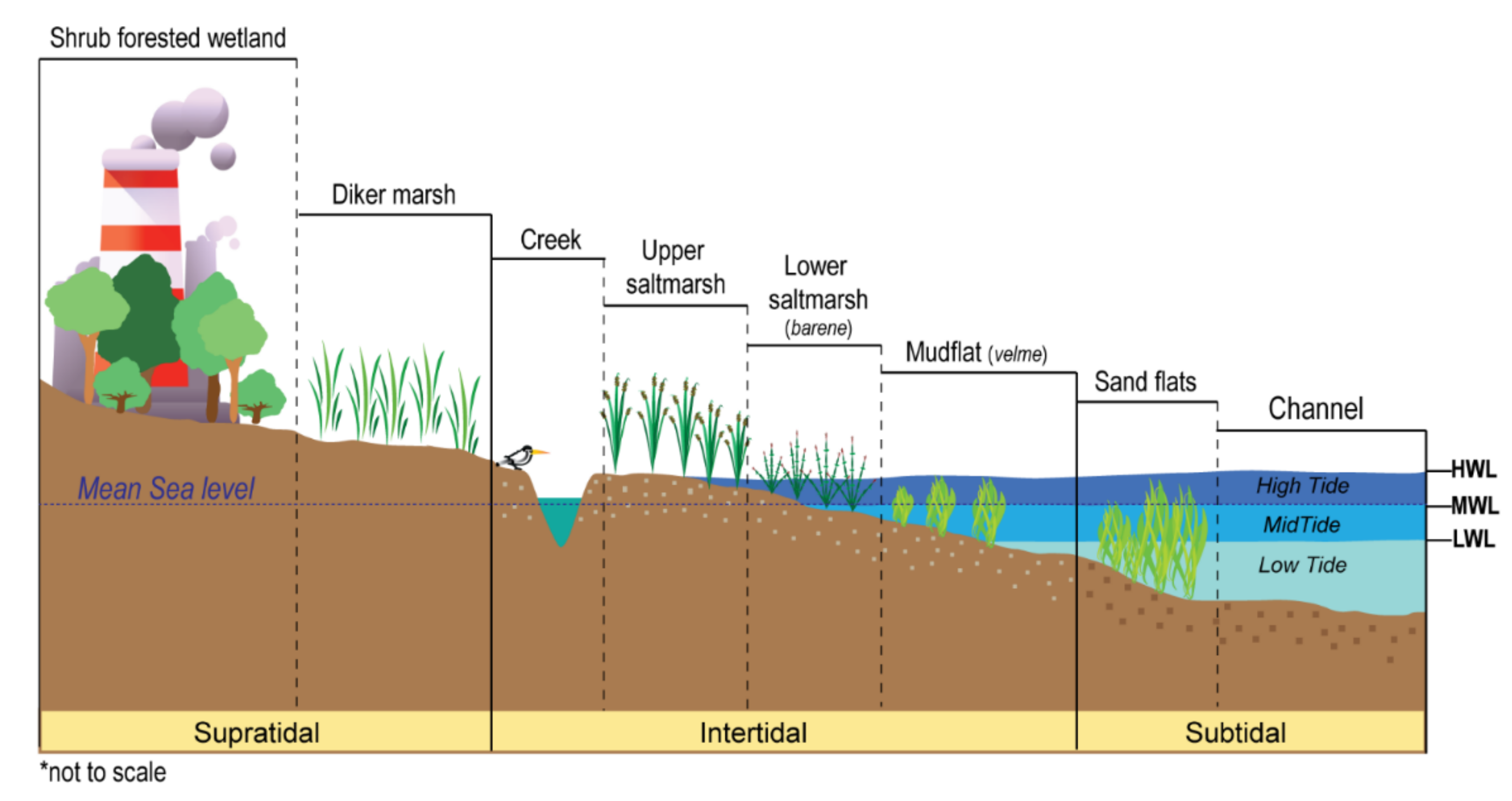
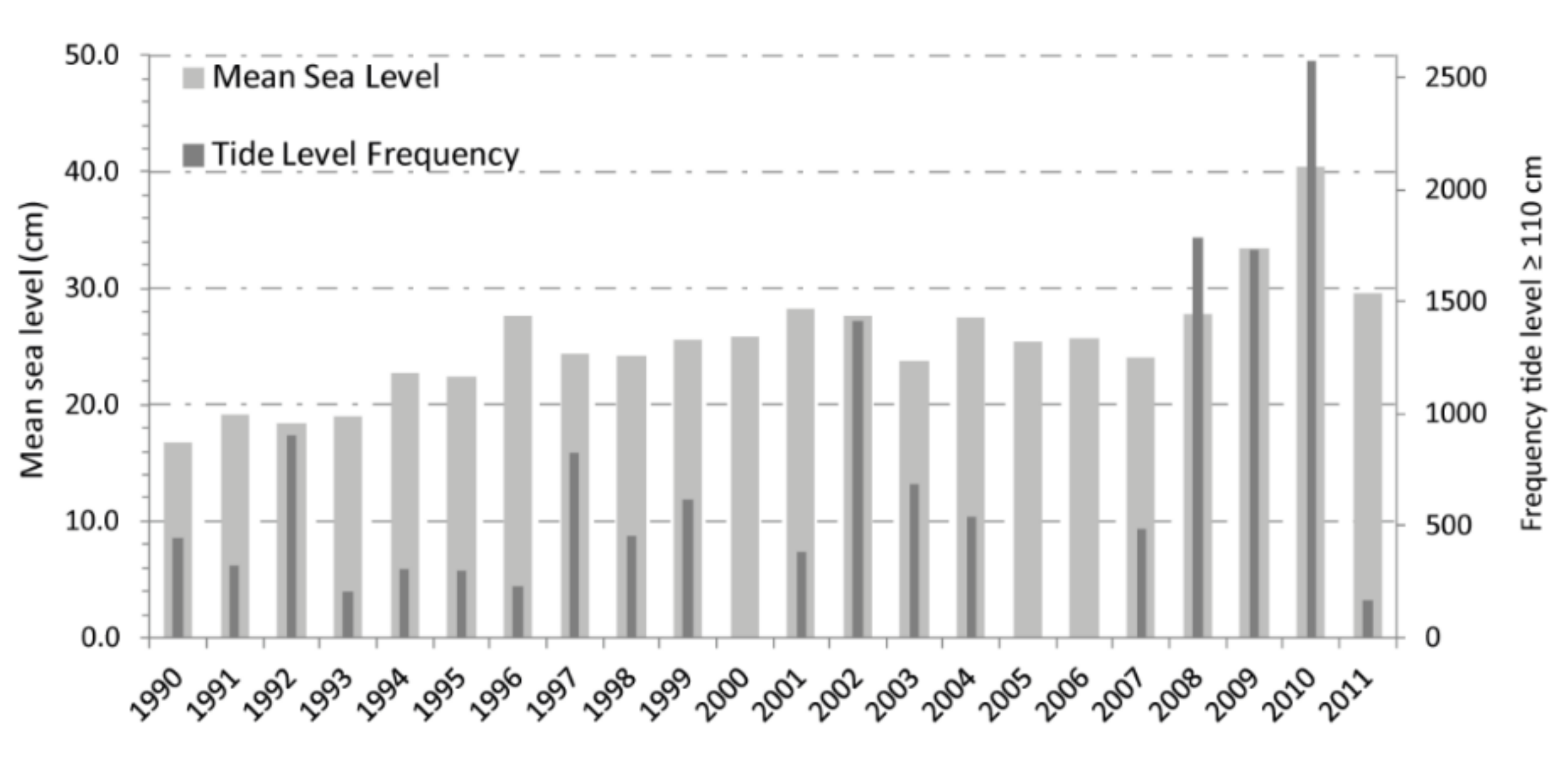

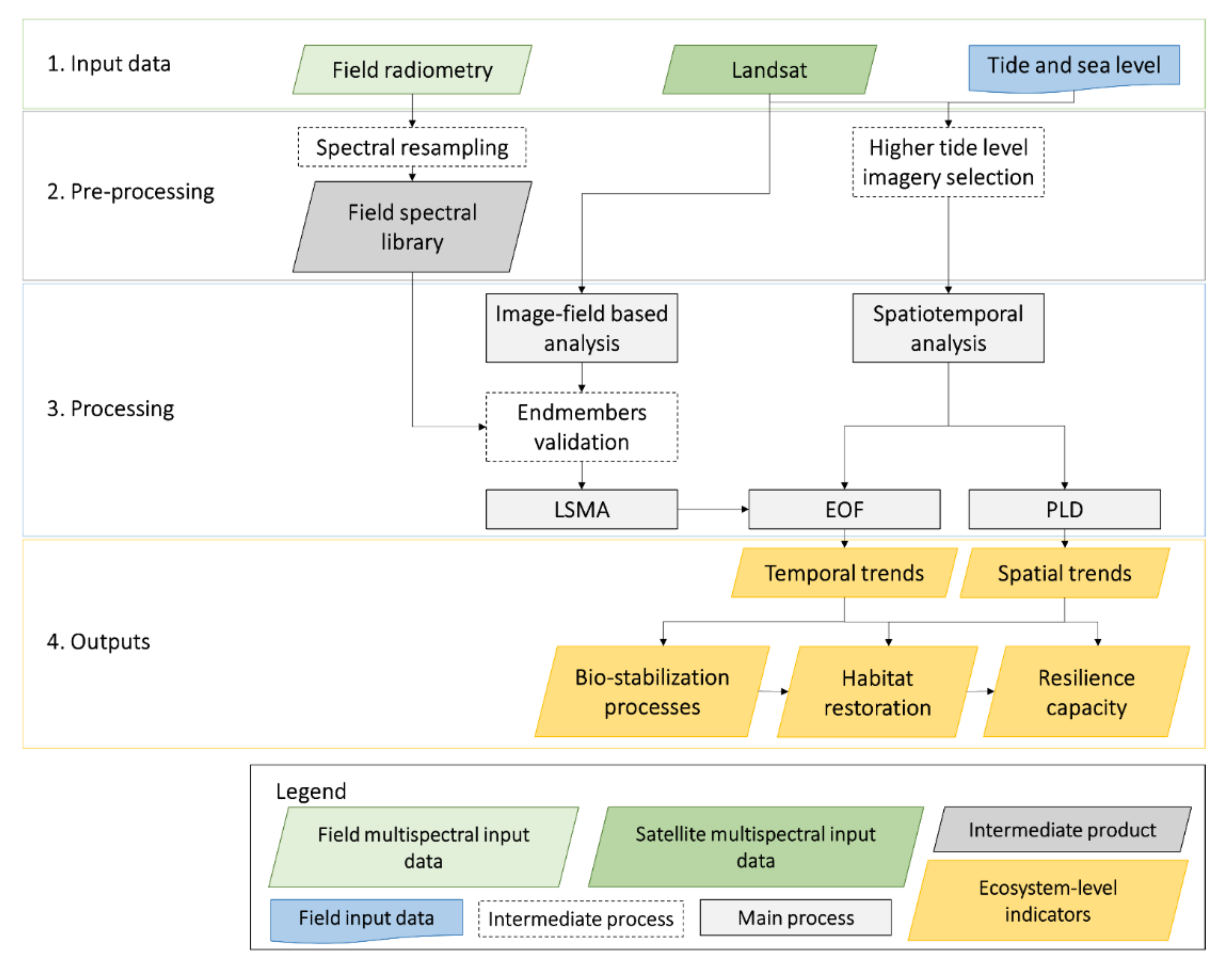
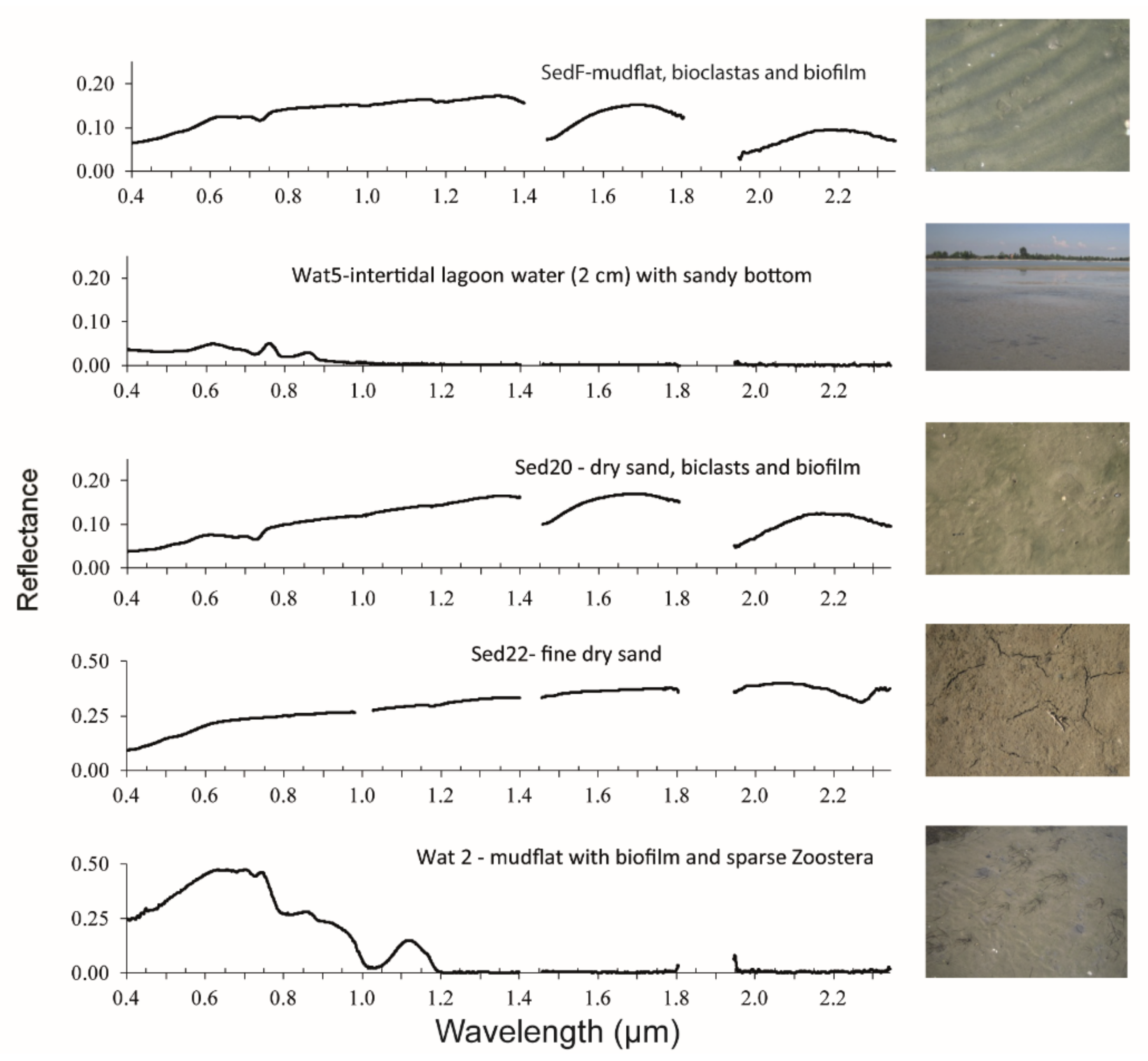



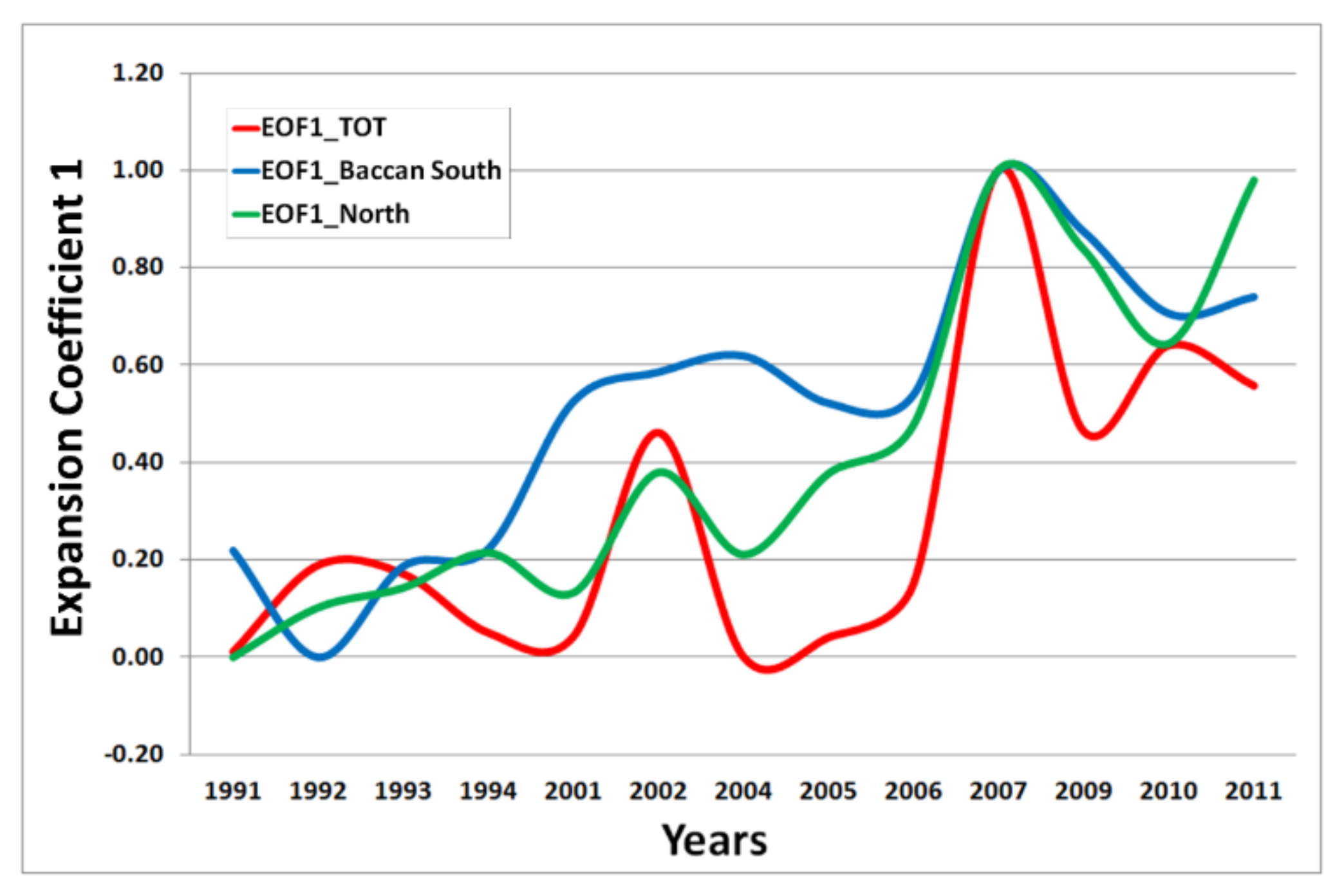
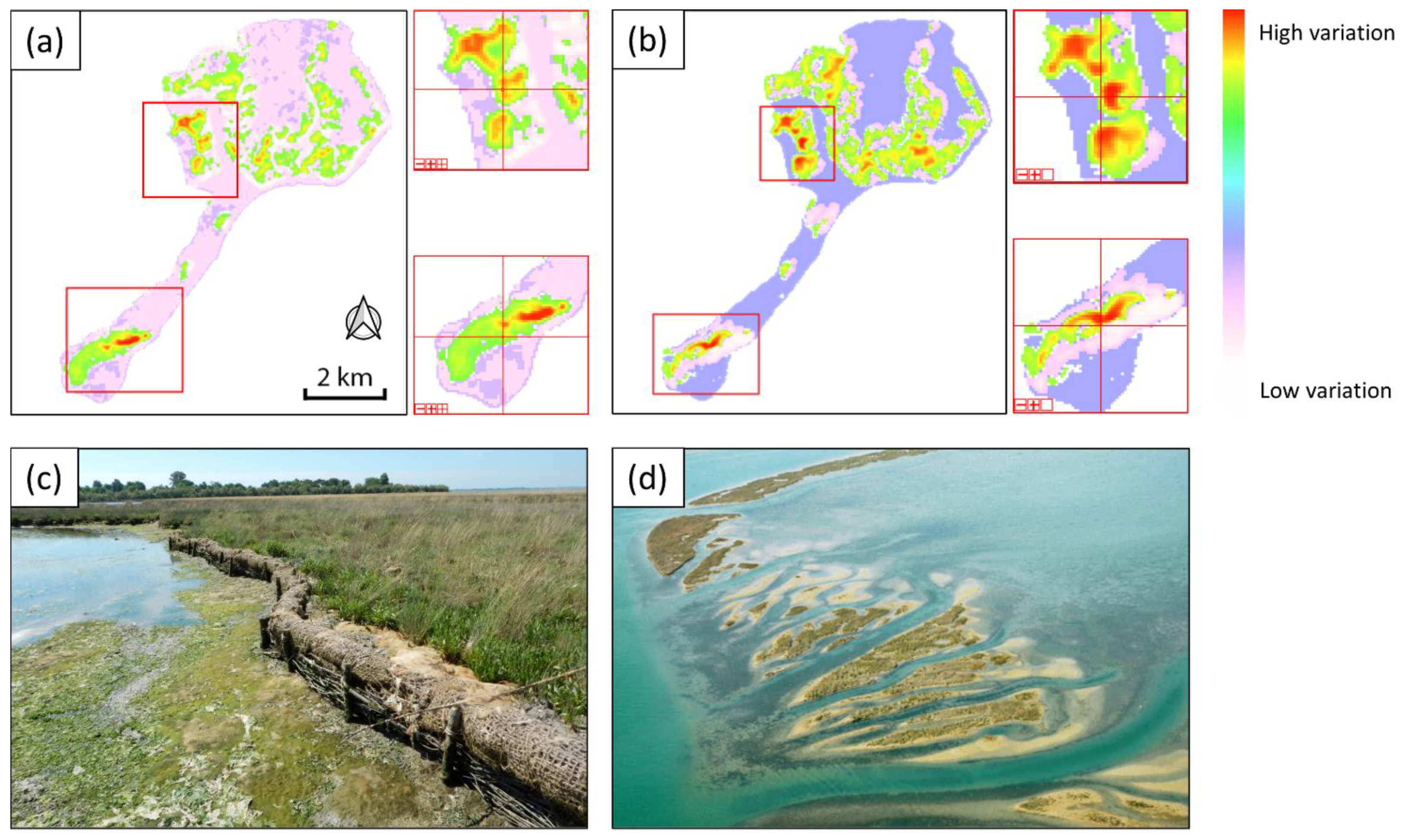


| Morphological Categories | Bathymetry (m) | Surface (km2) |
|---|---|---|
| Islands | >0.5 | 100 |
| Intertidal marshes | from 0.0 to 0.5 | 30 |
| Intertidal flats | from −0.3 to 0.0 | 40 |
| Shallow areas | from −2.0 to −0.3 | 230 |
| Channels | <−2.0 | 60 |
| Fish farms | - | 90 |
| Parameters | Monthly Mean | Annual Mean | |||||||||||
|---|---|---|---|---|---|---|---|---|---|---|---|---|---|
| J | F | M | A | M | J | J | A | S | O | N | D | ||
| T (°C) | 3.80 | 4.73 | 8.30 | 12.49 | 17.75 | 21.24 | 23.42 | 23.56 | 19.18 | 14.65 | 9.27 | 4.76 | 13.59 |
| P (mm) | 42.40 | 47.86 | 48.93 | 74.48 | 72.63 | 64.81 | 57.03 | 72.55 | 103.79 | 98.12 | 90.30 | 72.62 | 70.46 |
Publisher’s Note: MDPI stays neutral with regard to jurisdictional claims in published maps and institutional affiliations. |
© 2021 by the authors. Licensee MDPI, Basel, Switzerland. This article is an open access article distributed under the terms and conditions of the Creative Commons Attribution (CC BY) license (https://creativecommons.org/licenses/by/4.0/).
Share and Cite
Taramelli, A.; Valentini, E.; Piedelobo, L.; Righini, M.; Cappucci, S. Assessment of State Transition Dynamics of Coastal Wetlands in Northern Venice Lagoon, Italy. Sustainability 2021, 13, 4102. https://doi.org/10.3390/su13084102
Taramelli A, Valentini E, Piedelobo L, Righini M, Cappucci S. Assessment of State Transition Dynamics of Coastal Wetlands in Northern Venice Lagoon, Italy. Sustainability. 2021; 13(8):4102. https://doi.org/10.3390/su13084102
Chicago/Turabian StyleTaramelli, Andrea, Emiliana Valentini, Laura Piedelobo, Margherita Righini, and Sergio Cappucci. 2021. "Assessment of State Transition Dynamics of Coastal Wetlands in Northern Venice Lagoon, Italy" Sustainability 13, no. 8: 4102. https://doi.org/10.3390/su13084102
APA StyleTaramelli, A., Valentini, E., Piedelobo, L., Righini, M., & Cappucci, S. (2021). Assessment of State Transition Dynamics of Coastal Wetlands in Northern Venice Lagoon, Italy. Sustainability, 13(8), 4102. https://doi.org/10.3390/su13084102









